Landscaping is an art, and every artist needs their tools. Whether you’re just starting your landscaping business or looking to upgrade your current setup, having the right equipment can significantly impact the quality and efficiency of your work.
If you’ve ever wondered what tools are needed for landscaping, you have come to the right place. In this guide, we’ll walk you through the must-have landscaping tools and give you tips on how to choose and maintain them for the best results.
Landscaping Tools You Should Have on Your List
When planning your landscaping tools list, you might ask, what tools do I need for landscaping? Here is an extensive list of all the tools and equipment you need for your landscaping business.
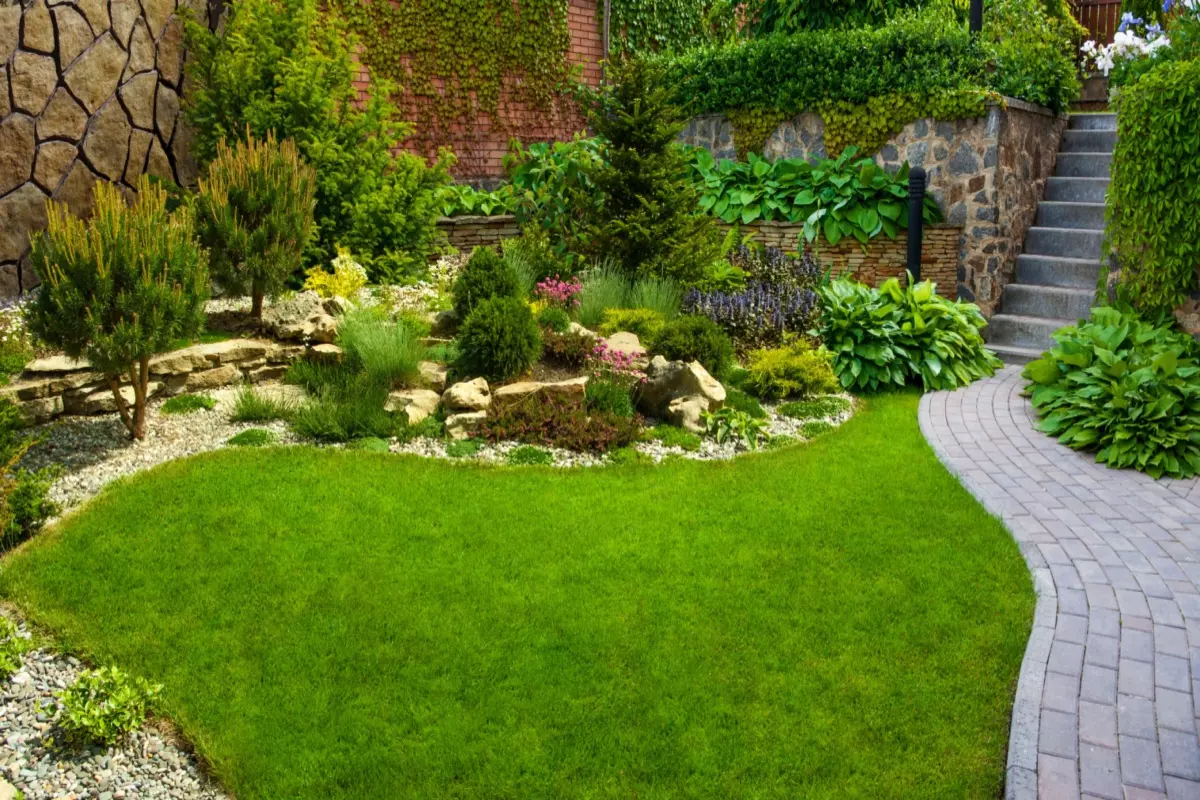
Landscaping Power Tools List
Any landscaping business has to have power tools. Here are the most popular power tools for landscapers and some tips on what to consider before purchasing them:
Lawn Mower
A reliable lawn mower helps maintain large lawns quickly, a key item on your lawn tools list. Before purchasing one, consider the size of the lawns you will be servicing. You can choose to push mowers for smaller areas and riding mowers for larger properties.
Prices can range from $200 for basic models to $3,000 or more for commercial-grade options.
String Trimmer
A string trimmer is great for trimming edges and areas that mowers can’t reach. They are used to give finishing touches to fences, trees, and garden beds. Before you get one, make sure it comes with adjustable shafts and comfortable grips to make sure they are easier to use and less tiring during long jobs.
Depending on the features, you can expect to pay between $80 and $400.
Leaf Blower
A leaf blower clears leaves and debris, keeping properties tidy. When choosing a leaf blower, consider the noise level and whether you prefer a gas, wired, electric, or battery-powered model. For example, gas-powered models are typically the most powerful and work best for large properties or commercial use. However, they are noisier and require more maintenance, such as fuel and oil changes. They also emit exhaust fumes, which might be a consideration for environmentally-conscious landscapers.
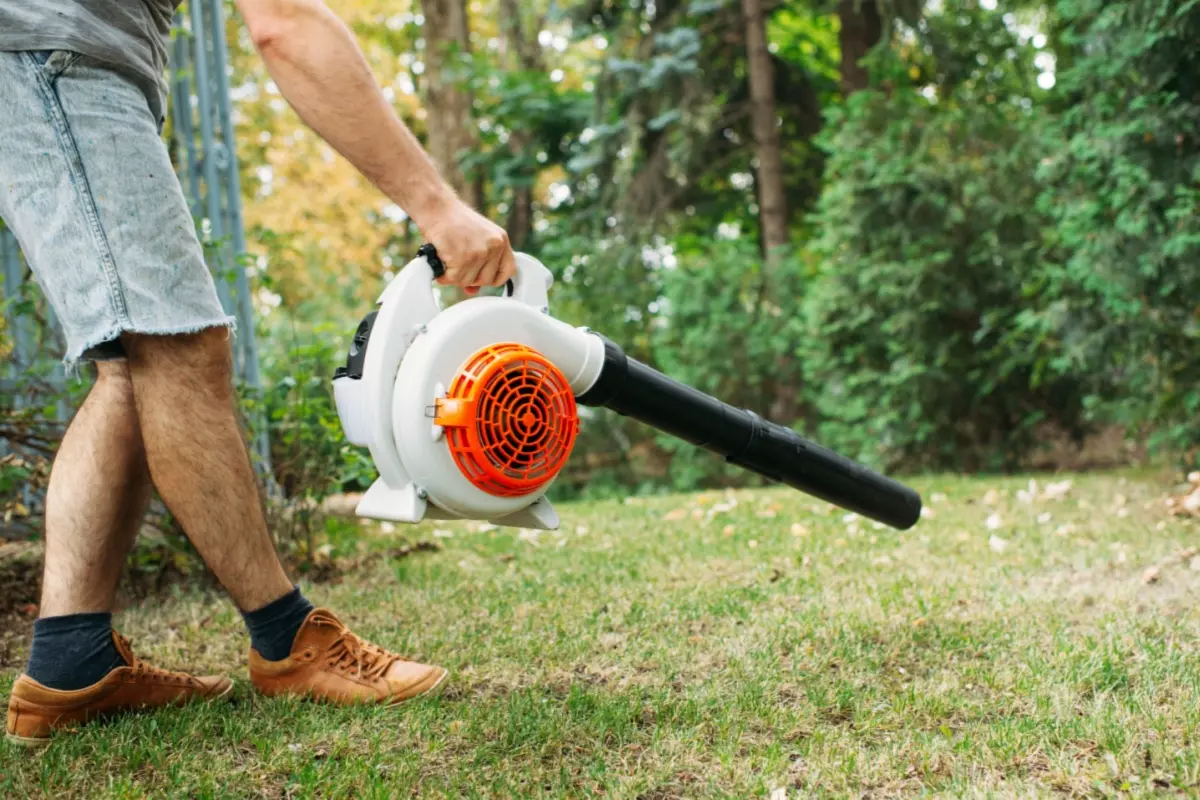
Wired electric leaf blowers are quieter and lighter than gas-powered ones. They require an electrical outlet and a cord, which can limit mobility, but they get the job done for smaller areas or properties with easy access to power. Electric leaf blowers are also more affordable and require less maintenance than gas models.
Battery-powered models are cordless, providing greater mobility and ease of use. They are also quieter and more environmentally friendly than gas blowers. However, they might not have the same power level as gas models, and their runtime is limited by battery life. That makes them well-suited for small to medium-sized properties.
Prices vary from $50 to $500, depending on the model.
Hedge Trimmer
A hedge trimmer is your go-to tool for shaping hedges and shrubs, achieving a cleaner look. Like leaf blowers, before buying a hedge trimmer, decide whether you prefer corded, cordless, or gas-powered models based on the size of the job and your mobility needs.
These can cost anywhere from $50 to $300.
Chainsaw
A chainsaw comes in handy for cutting through thick branches and trees. As chainsaws are extremely dangerous tools, look for safety features and easy maintenance options before purchasing one, like chain brakes, anti-vibration handles, and tool-free chain tensioning.
Chainsaws can cost from $70 to $500. When adding them to your landscaping tools list, prioritize safety and efficiency.
Landscaping Hand Tools List
While power tools offer convenience, hand tools provide precision and versatility. Here are some basic tools that every landscaping business should have on hand.
Shovel
Add a shovel to your landscaping equipment list and use it for digging, moving soil, planting, and removing debris. When choosing a shovel, look for one with a comfortable handle and a durable blade that matches the type of soil you’ll be working with. For example, a rounded blade is great for digging, while a flat blade is better for moving soil.
Prices for these basic landscaping tools typically range from $15 to $50.
Rake
A good rake can make a big difference in leveling soil and gathering leaves or debris. There are generally two main types of rakes to consider: leaf rakes and garden rakes. A leaf rake has long, flexible tines to gather leaves and small debris without damaging the lawn. It is lightweight and easy to use.
On the other hand, a garden rake has shorter, sturdier tines. It is more robust than a leaf rake and designed for heavier tasks like leveling soil, spreading mulch, and breaking up clumps of dirt.
Depending on the type of rake you choose, prices range from $10 to $40.
Pruners
Pruners are necessary for trimming and shaping plants and shrubs. Like rakes, there are two main types to consider: bypass pruners and anvil pruners. Bypass pruners have two curved blades that slide past each other, like scissors, making clean cuts that are gentle on plants. Thus, they are used for cutting live, green plants.
Conversely, Anvil pruners have one straight blade that cuts down onto a flat surface, like a knife. So, they are used for cutting dead branches.
Prices for pruners can vary from $10 to $50 depending on the quality and features.
Trowel
Trowels can be used for various small gardening tasks, such as digging, planting, and weeding. The most common type of trowel is the garden trowel. Its pointed, scoop-shaped blade makes it easy to dig small holes for seedlings and bulbs.
Then, there is the transplanting trowel, which has a narrower blade that allows it to dig deep into the soil and move plants without disturbing their roots too much.
Lastly, the weeding trowel has a V-shaped blade designed to penetrate weed roots and pull them out completely.
Trowels generally cost between $5 and $25, depending on the material and durability.
Wheelbarrow
A wheelbarrow is useful for transporting soil, plants, mulch, and other materials. When choosing one, consider its load capacity. Typical loan capacities range from four to six cubic feet. For heavier tasks, like moving rocks or large amounts of soil, look for higher capacity, like six cubic feet. Smaller capacity wheelbarrows are easier to maneuver and better suited for lighter tasks.
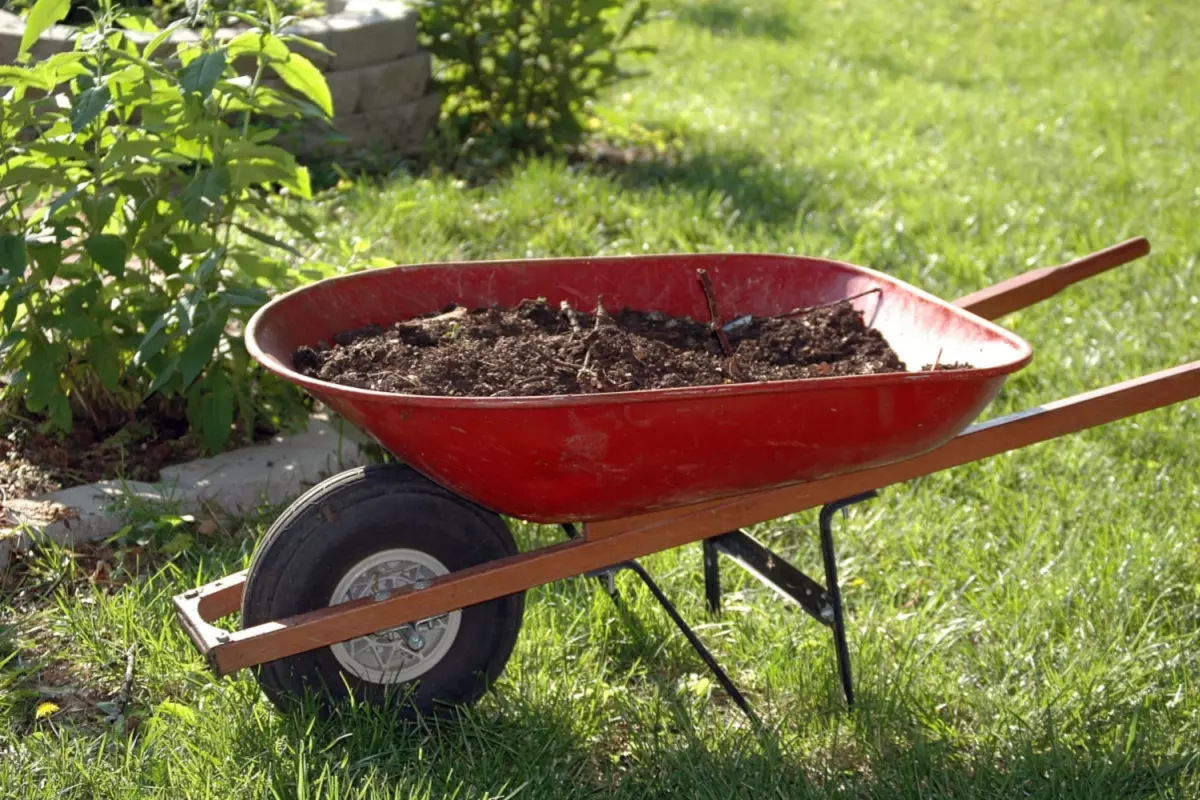
Also, consider whether you would need a single-wheel or dual-wheel wheelbarrow. Single-wheel wheelbarrows are more maneuverable, especially in tight spaces or uneven terrain. Dual-wheel wheelbarrows provide better stability and are easier to balance when carrying heavy loads.
Prices range from $30 to $150, depending on the capacity, wheel type, and overall build quality.
Landscaping Safety Equipment List
Lawn care tools and the outdoors can expose you to injuries. For that reason, you should always prioritize your safety and the safety of your team when working outdoors. Here’s a list of what you need to protect yourself and ensure a safe working environment.
Gloves
Gloves protect your hands from cuts, blisters, and chemicals. When choosing the material of your gloves, consider the tasks you frequently perform. For instance, consider leather gloves if you perform heavy-duty tasks like digging and handling rough materials.
If your tasks involve working with chemicals, like applying pesticides and fertilizers, consider nitrile gloves, as the material is chemical-resistant.
Lastly, if you undertake general gardening tasks like weeding, planting, watering, and pruning, consider fabric glovers, as they are breathable and comfortable.
Prices range from $5 to $20, depending on the type and quality.
Safety Glasses
Safety glasses shield your eyes from debris and harmful UV rays. When choosing one, make sure it meets the ANSI/ISEA Z87.1-2020 safety standard. Glasses that meet this standard have impact resistance and offer some protection against flying debris and UV rays. However, eye injuries can occur even with safety glasses.
Prices typically range from $5 to $30.
Ear Protection
Most landscaping power tools can be very loud, which can lead to hearing damage without proper ear protection. To prevent this, use earplugs and earmuffs with high Noise Reduction Ratings (NRR). The higher the NRR, the greater the noise reduction.
Also, consider how comfortable it will be to wear for extended periods to maximize its effectiveness. For instance, earplugs are lightweight and fit inside the ear canal, while earmuffs cover the entire ear and can be more comfortable for long-term use.
Prices vary from $5 for basic earplugs to $50 for high-quality earmuffs.
Work Boots
As a landscaper, you spend a lot of time working on your feet and are exposed to heavy and dangerous objects. You need sturdy boots that can provide support while protecting your feet from landscaping tasks.
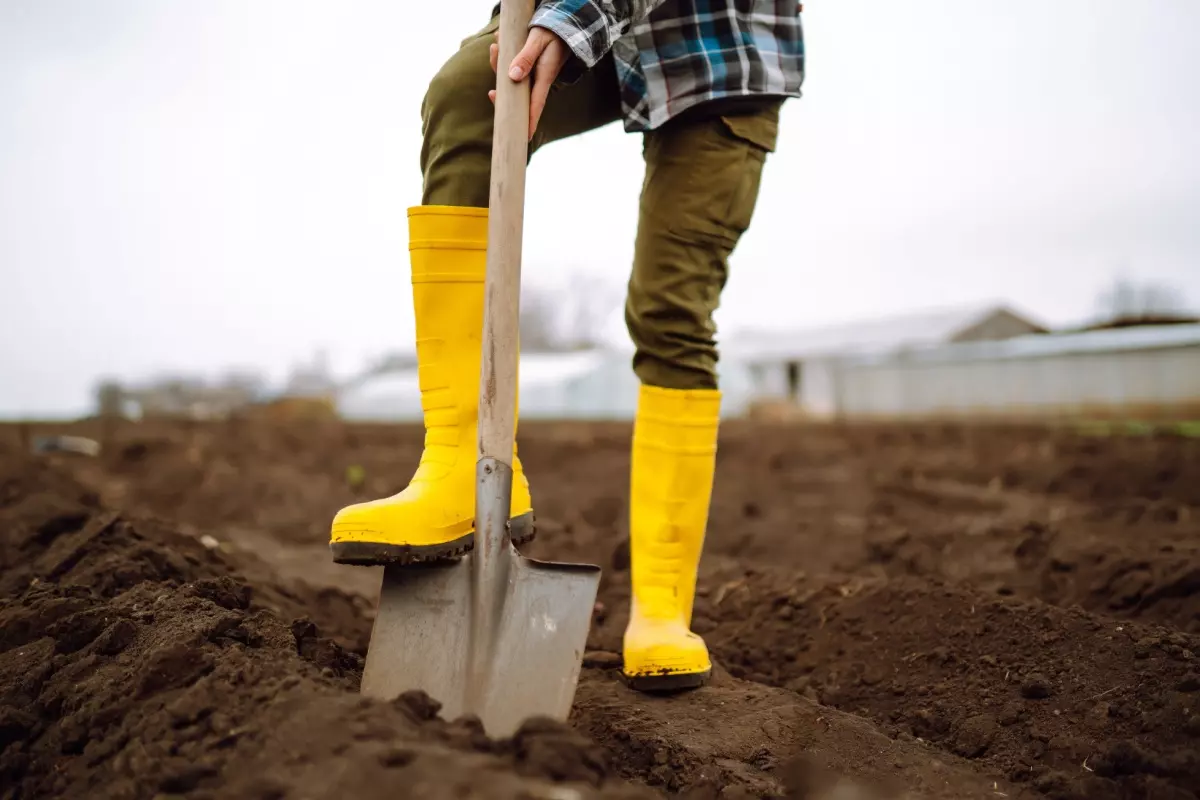
Look for steel-toe boots to protect you from heavy falling objects and compression injuries. At the same time, make sure it has slip-resistant soles to help prevent slips and falls on wet or uneven surfaces. Lastly, make sure it is made of waterproof materials to keep your feet dry and comfortable in all weather conditions.
Prices can range from $50 to $200 depending on the feature and quality.
Lawn Care Equipment List
Include these pieces in your lawn care equipment list for a well-manicured lawn. Each plays a specific role in maintaining a lush and healthy lawn.
Lawn Aerator
A lawn aerator creates small holes in the soil to ensure proper air and water flow to the roots. Aeration promotes healthier grass growth and reduces soil compaction.
When choosing a lawn aerator, consider the size of the area you need to aerate. For small lawns, a manual aerator might be enough and more cost-effective. A powered aerator can help you save time and effort for larger areas.
Also, consider your budget. Manual aerators are cheaper and quieter but require more physical effort. At the same time, powered aerators are more expensive but easier to use and faster for large lawns.
Prices range from $30 for manual aerators to $300 or more for powered models.
Spreader
As the name suggests, a spreader evenly distributes seeds, fertilizers, and other materials across the lawn. Using this tool ensures consistent coverage and prevents over-application.
There are two main types of spreaders: broadcast and drop. Broadcast spreaders cover large areas quickly by fanning out the material in a wide pattern. This option is better if you work on big lawns, as it can save time. However, it may be less precise and unsuitable for areas where careful application is needed, like garden beds.
On the other hand, drop spreaders are slower than broadcast spreaders but ensure even distribution as they release material directly below the hopper in a narrow band. They offer precision, making them great for small lawns or areas requiring exact application.
Spreader prices typically range from $20 to $200, depending on the type and quality.
Other Essential Landscaping Tools List
These essential tools for landscaping may not be the first ones you think of, but they are just as important:
Measuring Tape
If you offer landscape design services, you may want to add a measuring tape to the list. It ensures accurate measurements and precise placement of plants, pathways, and other features.
Measuring tapes range from 25 to 100 feet. A 25-foot tape will do the job for you if you work on smaller projects and tight spaces. A 50- to 100-foot tape is better for larger landscapes where you need to measure longer distances.
Also, be mindful of the material that you choose to ensure durability. Look for tapes made from fiberglass or stainless steel. Fiberglass tapes are lightweight, flexible, and resistant to stretching, making them ideal for outdoor use. Stainless steel tapes are more durable and resistant to wear and tear but can be heavier.
Prices range from $5 to $30.
Edger
Edgers create clean lines along sidewalks and flower beds, giving your landscape a neat and defined appearance. They come in manual and powered versions. Manual edgers are less expensive and good for small areas because they don’t require external power. They are ideal for detailed work and tight spaces where precision is needed.
Powered edgers, on the other hand, are better for larger projects because they can cover more ground quickly and with less physical effort.
Prices vary from $20 for manual models. Powered ones come at a higher cost, around $200 or more, due to their mechanical components.
Weed Puller
A weed puller is specifically designed to remove weeds without damaging plants. It has a long handle and a forked or V-shaped design. This design helps it dig deep to reach the roots of weeds and pull them out entirely, preventing regrowth.
Weed pullers are particularly effective for dandelions and other deep-rooted weeds.
Prices can range from $10 to $50.
How to Choose the Best Landscaping Tools For Your Business
The landscaping tools you select can make a big difference in the efficiency and quality of your work. Here’s how to choose the best tools for your landscaping tools kit.
Determine Your Budget
The first step is setting a budget for your tools. Consider your immediate needs and plan for future expansions. While high-quality tools can be a significant investment, they often pay off in the long run due to their durability and performance.
To maximize your budget, look for seasonal sales and bundle deals at hardware stores, garden centers, and online retailers. You can always consider flexible payment plans, which can help you manage the upfront costs of essential tools and equipment. Many contractors offer landscape financing options to their customers, allowing them to spread out the expense over time without compromising on the quality of their tools.
Choose Quality Products
Again, quality tools may have a higher upfront cost, but they can save money over time by reducing downtime and replacement costs.

Research customer reviews and ratings to find products that have proven their worth in real-world use. Some reputable brands known for their reliability that you can invest in include Husqvarna, Stihl, DeWalt, and Toro.
Also, when choosing your products, consider features that enhance ease of use and efficiency, such as ergonomic designs and advanced technology. Keeping up with landscaping industry trends can help you stay informed about the latest and most efficient tools.
Pay Attention to Warranties
Warranties can offer peace of mind and protection for your investment. A good warranty indicates the manufacturer’s confidence in their product and provides support if something goes wrong.
So, look for tools with comprehensive warranties to ensure you’re covered in case of defects or issues. Also, read the fine print to understand what is covered and for how long.
Evaluate Your Needs
Assess the specific needs of your business and the types of projects you frequently undertake. For instance, if you handle a lot of tree trimming, invest in quality pruners and chainsaws from your landscaping tools list. For extensive lawn care, prioritize lawnmowers and aerators.
Tailor your tool selection to match these requirements to ensure you have the right equipment for the job. This is especially important if you’re wondering how to start a landscaping business and need to make strategic investments.
Consider Tool Versatility
Look for tools that offer multiple functions. These tools also help you save space and money.
For example, certain leaf blowers can also function as vacuums and mulchers, allowing you to clear leaves and create mulch without needing separate tools.
Many string trimmers can be converted into edgers with a simple adjustment, allowing you to trim and edge with the same tool.
Think About Storage and Maintenance
Proper storage extends the life of your professional landscaping tools and equipment. So, plan where and how you will store them. For instance, you can consider investing in storage solutions like sheds or cabinets.

Also, consider each tool’s maintenance requirements and whether you have the resources to keep them in good working condition and extend their lifespan.
For example, a lawn mower requires regular blade sharpening, oil changes, and air filter replacements. A string trimmer needs periodic replacement of the trimmer line and regular cleaning. Pruners and shears need regular blade sharpening and lubrication.
Evaluate Ergonomics and User Comfort
Ergonomically designed tools can reduce strain and fatigue, improving productivity and safety. So, before purchasing a tool, test it for grip, comfort, and weight. Choose those that are comfortable to use, especially for long periods.
Check for Local Supplier Support
Having local support can be beneficial for quick repairs and parts replacement. Check if there are local suppliers or service centers for your chosen brands. This can minimize downtime if a tool needs servicing.
Research Environmental Impact
Consider the environmental impact of your tools. Electric or battery-powered tools may have a smaller carbon footprint compared to gas-powered ones. Look for eco-friendly options that align with sustainable practices.
Safety Tips When Using Landscaping Tools
Ensuring safety while working with tools needed for landscaping is about preventing injuries and maintaining efficiency and productivity. Here’s what to keep in mind when using landscaping tools.
Wear Protective Gear
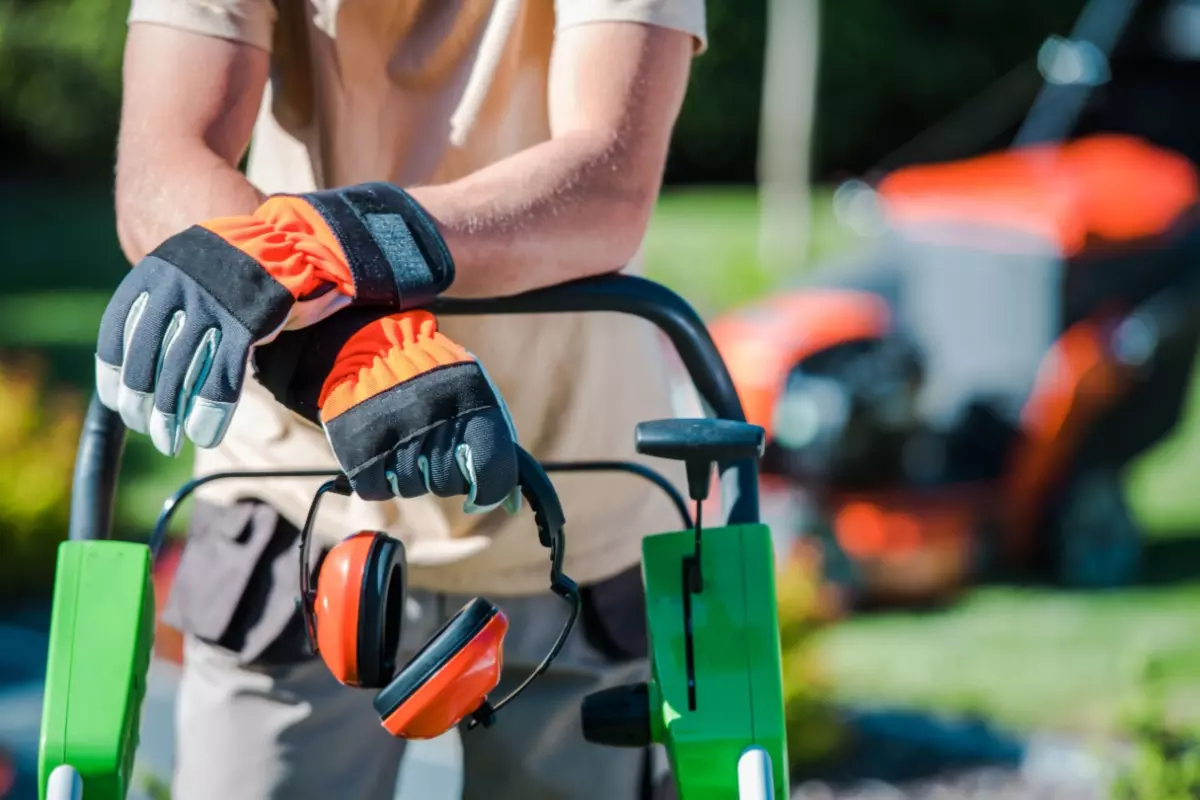
As we listed earlier, when discussing landscaping safety equipment, you must always wear the appropriate protective gear, including gloves, safety glasses, ear protection, and work boots. Investing in high-quality protective gear can greatly improve your safety and comfort.
Learn the Proper Techniques
Take the time to learn the proper techniques for using each tool. Proper usage ensures your safety and helps you use the tools more effectively and efficiently. For instance, knowing the correct way to hold and operate a chainsaw can prevent accidents and extend the life of the tool.
Many manufacturers provide instructional manuals and online videos to help you understand the best practices.
Be Aware of Your Surroundings
Awareness of your environment can prevent accidents and injuries. So, always be mindful of your surroundings while working. Look out for obstacles, uneven ground, and other potential hazards. Ensure that the area is clear of bystanders, especially children, and pets when using power tools.
Use Tools for Their Intended Purpose
Only use tools for their intended purpose. Misusing tools can lead to accidents and damage. For example, using a pruner to cut thick branches instead of a saw can break the tool and cause injury. Follow the manufacturer’s guidelines and recommendations for each tool.
Take a Break and Stay Hydrated
Landscaping work can be physically demanding. Take regular breaks to rest and stay hydrated, especially in hot weather. Fatigue can lead to mistakes and accidents, so listen to your body and take care of yourself.
How to Maintain Your Specialized Tools & Equipment
Regular maintenance of your tools can prevent accidents and prolong their lifespan because well-maintained tools are safer and more efficient to use. Here are some tips for keeping your tools in top condition.
Clean Tools After Use
After each use, clean your tools to remove dirt, sap, and debris. This prevents rust and ensures your tools stay in good working condition. Use a wire brush or cloth to clean off any soil and moisture. For sap and sticky residues, a mixture of water and mild detergent can be effective. Dry the tools thoroughly to prevent rusting.
Sharpen Blades Regularly
Sharp blades are essential for cutting and trimming effectively. To maintain their performance, regularly sharpen the blades of your mowers, pruners, and other cutting tools. If you don’t, dull blades can damage plants and make your work harder.
Invest in a good-quality sharpening stone or file and make sharpening a routine part of your maintenance schedule.
Keep Tools Organized
Proper organization protects your tools from damage and saves you time by making it easy to find what you need. Store your tools in a clean, dry place. Tool racks, pegboards, and storage bins can keep everything organized and easily accessible.
Lubricate Moving Parts
Lubricate your tools’ moving parts regularly to ensure smooth operation. Use oil or a lubricant spray on hinges, springs, and other moving components. This reduces friction and wear, prolonging the life of your tools.
Inspect Tools for Damage
Periodically inspect your tools for any signs of damage or wear. Look for cracks, loose parts, or any other issues that could affect performance or safety. Addressing small problems early can prevent larger, more costly repairs or replacements.
Follow the Manufacturer’s Maintenance Guideline
Always follow the maintenance guidelines provided by the tool manufacturer. These guidelines are specific to the design and materials of the tool and can help you maintain them properly. Keep manuals handy for reference and ensure you adhere to the recommended maintenance schedule.
Final Thoughts
The success of your landscaping business hinges on more than just skill; it depends on having reliable, versatile tools that you can count on. By following the tips in this guide, you can build a landscaping tools list that meets your needs and supports your business growth. Remember, well-chosen and well-maintained tools are the foundation of exceptional landscaping work.


